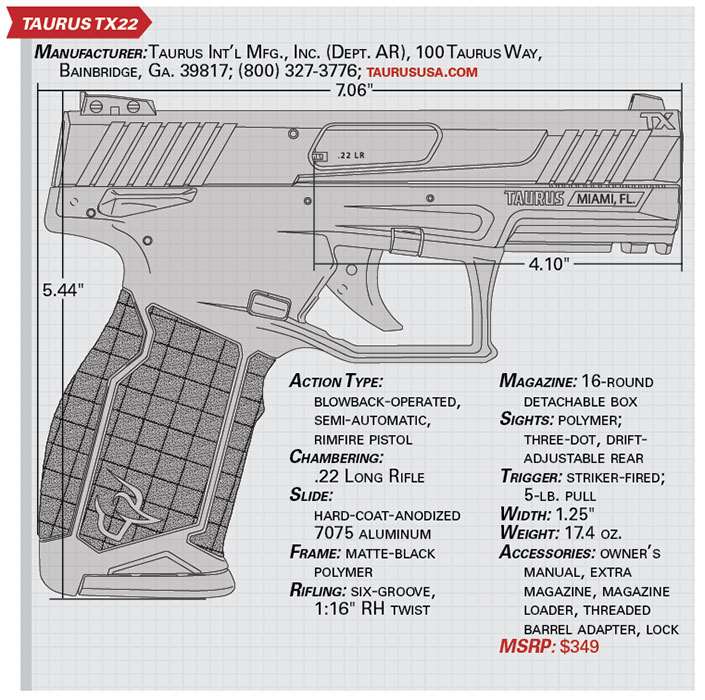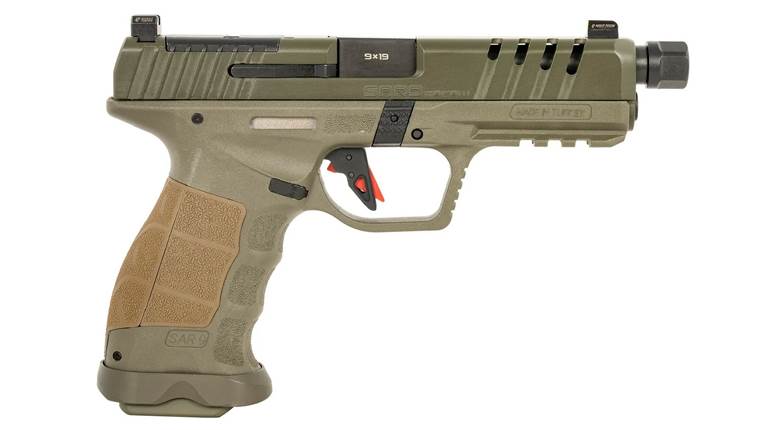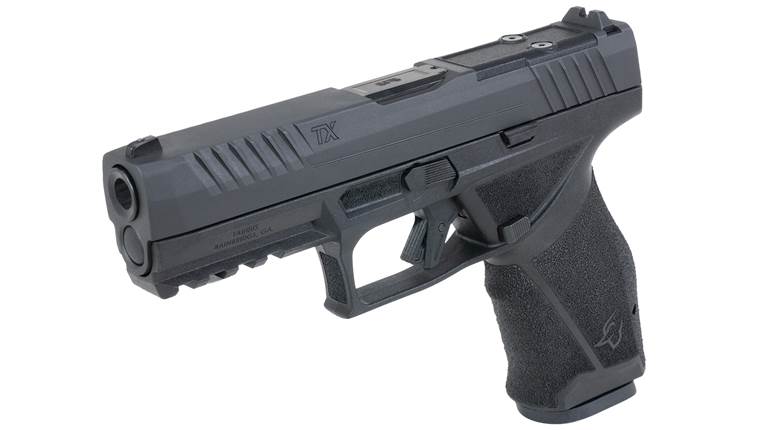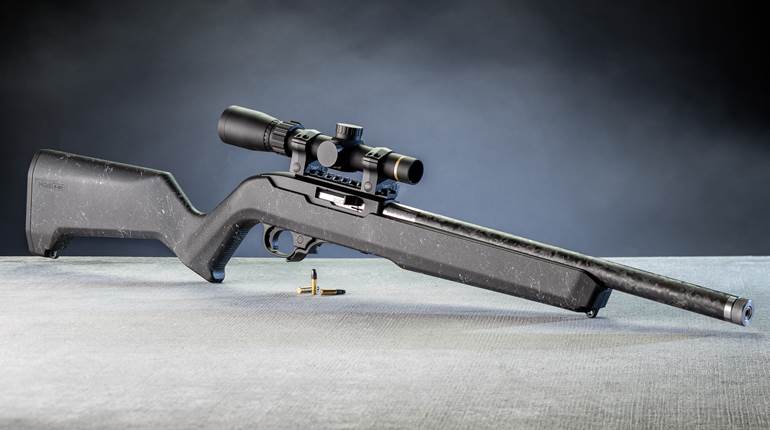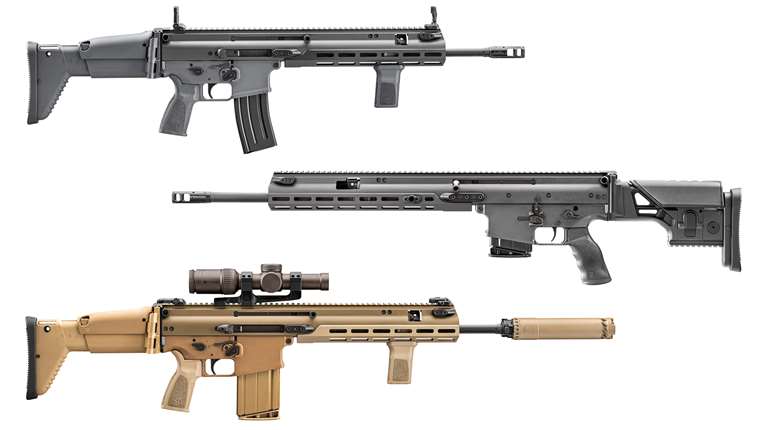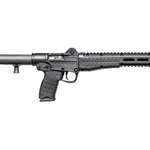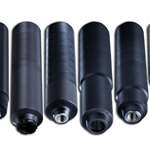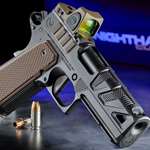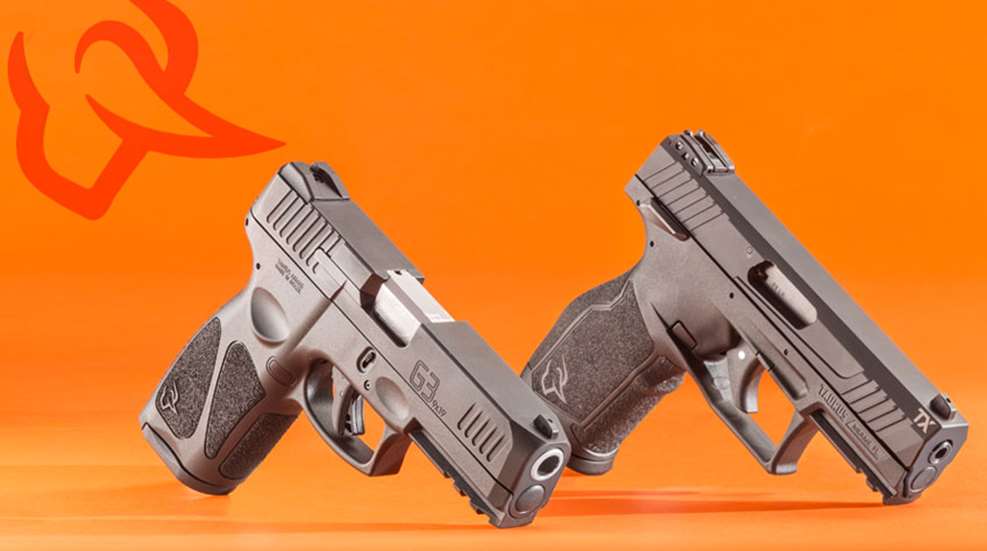
Taurus Int’l is known for producing innovative handguns that sell at fair prices. A variety of the company’s outside-the-box offerings have flourished, including factory-ported revolvers, the .45 Colt/.410 bore Judge and the Raging Bull and Raging Hunter series of hunting revolvers. That said, a few of the more gimmicky options, such as the translucent-sideplate View revolver or the Curve pocket pistol, have not fared so well.
This year Taurus has chosen to take a break from stretching the boundaries of conventional design by introducing new models that focus on practical answers to customers’ requests, along with a continued emphasis on quality construction and reliability. For those in the market for a compact, double-stack 9 mm Luger pistol, the new G3 is the next step in the evolution of the popular G2 semi-automatic pistol series. And, designed and built right here in the United States, the new TX22 chambered in .22 Long Rifle successfully breaks the single-stack rimfire pistol magazine mold with an adroitly designed 16-round-capacity magazine.
Taurus G3 9 mm Luger Pistol
To say that the mid-size, striker-fired 9 mm pistol market is crowded with options these days would be something of an understatement. Often inspired by the success of Glock’s G19, these polymer-frame, double-stack semi-automatics provide larger grips and increased ammunition capacities when compared to sub-compact pocket pistols. Yet their dimensions make them compact enough to carry comfortably and conceal more easily than duty-size models.
Taurus clearly targeted this segment of the market in 2005 with the release of the Millennium series of striker-fired pistols. In 2013, the company introduced the updated Millennium G2. This new model shipped with a company emphasis on low cost and improved quality. The rate of pistol returns dropped significantly, while real-world prices for the G2s hovered around $200. This led to an increase in consumer confidence, which, in turn, has provided support for the development of the company’s latest offering, simply called the G3, which has a suggested retail price of around $350, depending on the configuration.
Like its predecessors, the G3 is a striker-fired semi-automatic pistol made in Brazil that employs a short-recoil, locked-breech action. Although some G2 cosmetics have been preserved, the 9 mm Luger G3 incorporates some key changes into its design. It will eventually be available in a variety of finish options and with different magazine sets. For this review, the G3 sent for evaluation has a matte-black, carbon-steel slide and shipped with one blued steel, 15-round, flush-fit magazine and a second extended, 17-round magazine with a fitted polymer sleeve that acts as a grip extension.
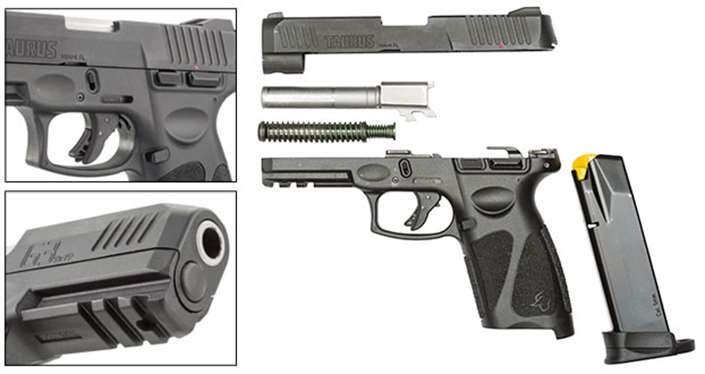
The low-profile polymer sights feature white dots, front and back, with a rear sight that is drift-adjustable for windage. The deep flutes located at the muzzle end of some Millennium G2 models have been replaced with a squared-off profile that allows for front cocking serrations to match those found at the rear. While the slide does have a square profile, the nose is beveled and the back end is well-rounded to give it a snag-free profile. The ejection port is beveled for improved function, and the slide is fitted with an oversize extractor claw.
The 4" stainless steel barrel is cut with traditional land-and-groove rifling, making it safe to fire with lead bullets. A witness hole on the top of the barrel’s chamber acts as a loaded-chamber indicator. The interior configurations of the slide and frame have clearly been influenced by the Glock Safe Action design. The barrel is supported by a dual recoil spring assembly consisting of steel rods and captured round-wire springs.
The polymer frame has been thoughtfully designed to fit comfortably in the shooting hand. The trigger guard has been lifted from the G2, while the grip shape has leanings toward the Smith & Wesson M&P design. The dustcover features a molded 2" accessory rail. The rail contains a serial numbered plate with additional copies of that number found above the trigger on the left side of the frame and on the barrel’s chamber. Just behind the rail are left- and right-side indentations (Taurus calls them Memory Pads) that provide a resting place for the tip of the trigger finger.
The metallic slide catch and manual safety lever are located on the left side of the frame along with a polymer magazine release button that is reversible for left- or right-handed operation. The top of the grip features thumb shelf indentations, which were a good fit for my somewhat smaller hands. The polymer trigger features an integrated safety lever and second-strike capability. This means that unlike many striker-fired pistols, the trigger can be pulled a second time if the firing pin lands on a hard primer. The trigger of this particular pistol exhibited a light, smooth take-up before breaking cleanly with 4 lbs., 5 ozs., of pressure. The trigger reset is short and distinctive, to contribute to quicker follow-up shots.
The grip has a total of six molded-in texture panels to provide added purchase on all sides. It’s an aggressive texturing comparable to skateboard tape, meaning a rough grit texture that feels almost like sand-paper. Some folks prefer this aggressive texturing because it’s exceptionally effective with shooting gloves and in wet conditions. The trade-off is that it can be abrasive to clothing or to bare hands during extended shooting sessions. Because the texture is incorporated into the grip, it’s a take-it-or-leave-it proposition.
The magazine well is dimpled on either side to allow the magazine base to be gripped and pulled out in case of a malfunction. A short extension at the base of the grip’s backstrap prevents the magazine base from pinching the shooting hand. Internal and external safeties include a manual safety lever, the trigger safety and a firing-pin block. The model tested does not have a magazine safety, meaning the pistol can fire with the magazine removed from the grip frame.
Dismantling the G3 for cleaning follows a simple procedure. Before starting, remove the magazine and open the action to verify the pistol is completely unloaded. Begin with the slide in the closed position. Retract the slide 0.25" and hold in that position. Pull down the takedown lever and release, and then press the trigger. The slide can then be run forward off of the frame. Remove the recoil assembly and barrel from the slide, and the pistol is ready to clean.
When evaluating Taurus offerings, I tend to go over them with a fine-tooth comb inspecting their overall quality, fit and finish. I’ve been examining and shooting this company’s handguns for nearly 25 years now and, to be honest, not all of them have been winners. However, the production-grade G3 I worked with was clean and well-made inside and out. The machining of the slide was top-notch and free of any dings, scratches or blemishes. The interior components were properly fit, and the exterior blends together neatly. The controls were smooth and operated correctly.
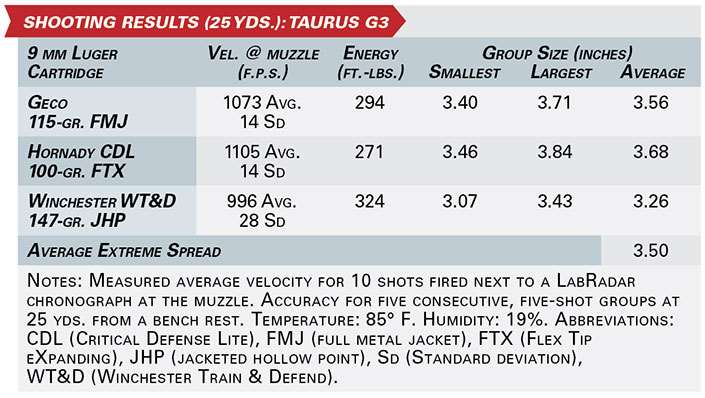
The trigger, in particular, is a step up from typical factory options in this class thanks to a clean take-up and short reset. The grip was also a comfortable shape to work with. The pistol was utterly reliable throughout the testing process with ammunition ranging from bulk-box practice loads to premium defensive rounds. With five-shot, bench-rested groups fired at 25 yds. hovering right around the 3.50" mark, I have no complaints about the pistol’s accuracy. Overall, it’s a solid option for regular trips to the range, daily concealed carry and home defense.
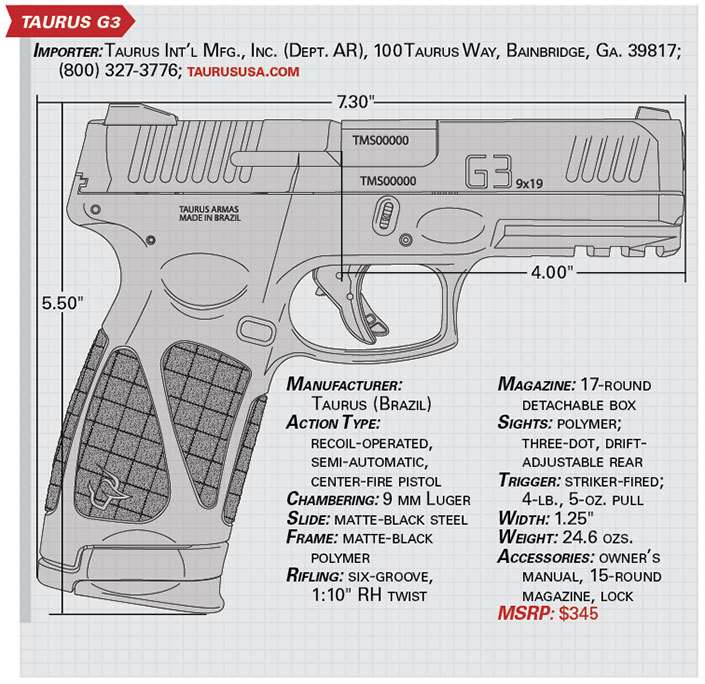
Taurus TX22 .22 Long Rifle Pistol
Although I am a dyed-in-the-wool fan of purpose-built rimfire handguns for plinking and practice, I haven’t invested much in models intended to replicate the look and feel of defensive center-fire pistols. With some notable exceptions, few have been enough like the guns they’re supposed to mimic to catch my fancy. They’ve generally been physically larger than a .22 needs to be with a bulky grip, a not-quite-right trigger pull and magazines that only hold 10 rounds instead of 15 or more. The result is a handgun without the benefits of a model built to make the most of the .22 Long Rifle cartridge while being a lackluster training substitute since its features are not the same as the center-fire pistol it’s modeled after.
Armed with my preconceived notions of what kind of gun the TX22 was going to be, I was surprised by how quickly it won me over. Not only does it successfully tackle the role of defensive pistol understudy it’s obviously meant to fill, it’s an enjoyable, reliable, stand-alone rimfire pistol in its own right.
The TX22 is a blowback-operated, striker-fired semi-automatic designed for competition and casual plinking. Although it is not a clone of any particular defensive center-fire pistol, it has the looks, features and feel of popular compact models. The first time I picked it up I couldn’t help but notice how light the TX22 is. According to a digital postal scale it’s just 17.4 ozs. with an empty magazine in the grip frame. Not only does this low weight make it a joy to practice with at the range, it makes the pistol a comfortable carry companion for outdoor adventures.
The square-profile slide is machined from 7075 aluminum and treated with a matte-black, hard-coat-anodized finish. The top edges of the slide are beveled, as is the ejection port, with cocking serrations milled into the slide at the front and rear. The polymer three-dot sight system consists of a fixed blade in the front and a rear sight with two adjustment screws for windage. A steel block is pinned inside the slide to support the barrel’s chamber and the spring-loaded extractor.
The muzzle of the 4.10" barrel fits flush to the slide. Retracting the slide reveals a muzzle threaded 1/2x28 TPI and fitted with a removable thread protector. The pistol arrives with a threaded adapter in the box that allows suppressors, muzzle brakes and other devices to be attached to the barrel. Including this adapter is a nice touch since finding aftermarket adapters can often be a challenge.
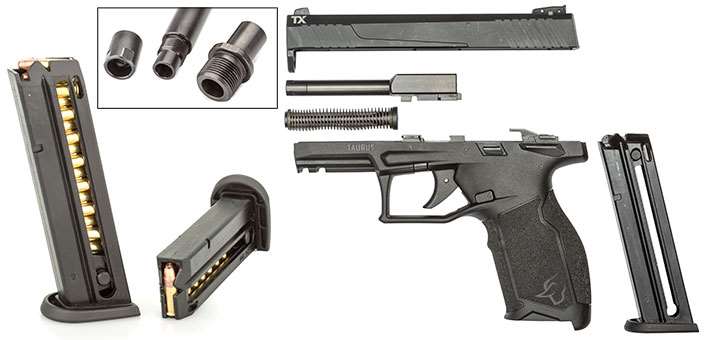
Removing the slide from the frame reveals an aluminum support block pinned into the frame just above the trigger assembly. This block houses the takedown lever extension and two sets of support rails, all of which work together to lock the barrel’s chamber into the support block. It’s a smart design that provides the stability of a fixed barrel while allowing the barrel to be removed for cleaning or replacement. The front set of rails also has extensions that support the slide. A third set of rails support the slide at the rear of the frame just above the external safety lever. The recoil assembly consists of a polymer guide rod with a captured flat wire spring.
The styling of the TX22’s polymer frame, including the finger rest trigger guard, takedown lever and grip shape, has been strongly influenced by the Walther PPQ series of pistols but without the interchangeable backstraps. A 1.75" accessory rail is molded into the dustcover along with left- and right-side grooves that provide resting points for the tip of the trigger finger. The serrated metallic magazine release is reversible for left-handed use. The slide stop is on the left side of the frame, and models both with and without bilateral thumb safeties are offered.
Rather than having a safety lever in the center of the trigger, the TX22 has a polymer trigger shoe that wraps around the trigger. This shoe is hinged to swing slightly, to disengage the safety, before depressing the trigger that rests inside of it. The trigger pull is 5 lbs. even, with a slightly mushy takeup and a break that feels like the typical factory triggers found on striker-fired defensive pistols. This model does not have the second-strike capability of the 9 mm G3. The grip features molded-in texturing that wraps around it for improved purchase. It’s an effective texture option without being as aggressive as the G3.
Once you see the TX22’s polymer magazine, you’ll wonder why it’s taken so long for a gunmaker to produce it. The answer is that getting any rimfire semi-automatic pistol to run reliably with the broad range of .22 Long Rifle bullet types and power levels is a tricky business. Moving away from the proven single-stack magazine design, which sets the rims of the cartridges directly on top of each other, took some careful consideration. Technically speaking, the TX22 is not a double-stack magazine; it’s a single-stack because the cartridge cases rest on top of each other. However, the magazine allows the cartridge rims to kick out to the left and right as they are loaded. This allows 16 cartridges to be stacked in a magazine that’s not much wider or longer than a traditional 10-round magazine.
Generally speaking, rimfire pistols have a reputation for being ammunition-sensitive. It’s not uncommon when testing .22 semi-automatics that certain loads, and even entire brands, will not operate reliably in a given model. Usually I discover at least one or two options that prove to be indigestible. Nonetheless, the TX22 proved to be one of the most ammunition-tolerant .22 pistols I’ve worked with. In fact, every load tested, from bulk-box plinkers to hunting-grade hollow points, operated properly without any hiccups or hang-ups. The only malfunction in the course of firing hundreds of rounds was a single failure to fire due to faulty priming, which was not the fault of the pistol.
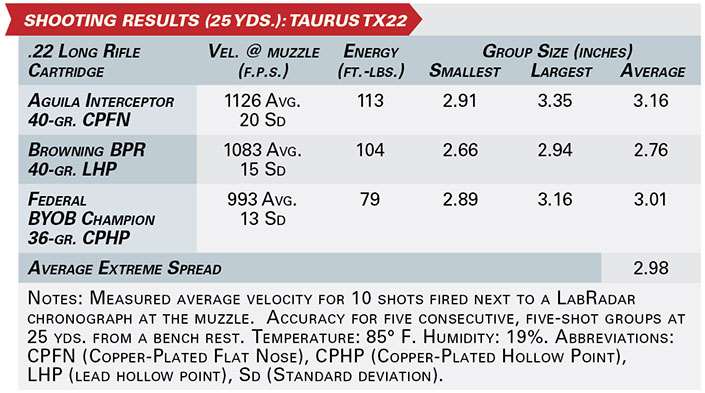
The TX22 exhibited an overall fit and finish, inside and out, that’s top-notch. I couldn’t find anything to complain about, which is quite a positive statement considering that I went into this review expecting the pistol to be a disappointment on some level. The slide and controls are smooth and easy to operate. The sights are useful, and the grip is comfortable. It ran reliably with all of the types of ammunition it was fed. The TX22 has a suggested retail price of $349, but real-world prices, as of this writing, are closer to $250. Considering this pistol’s affordable price, light weight and 16-round magazine, it’s a real bargain for use at the range or in the field.
